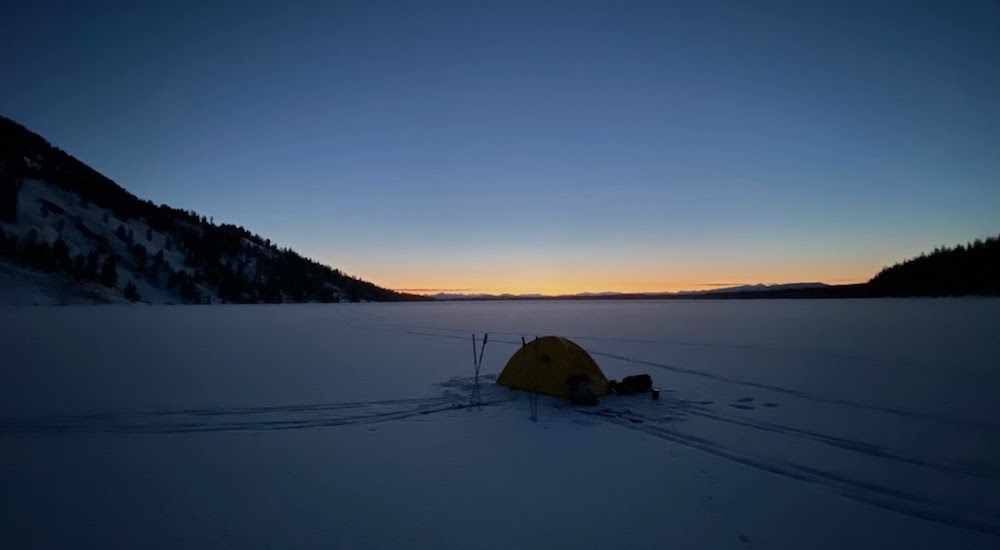
Here is our camp on Leigh Lake at sunrise. We had written off the idea for a big day, but rather decided to spend a nice tour scoping lines and enjoying time in the backcountry without a specific objective in mind.
In Part I of the Adventure From Home series Teton Edition, I started my planning process by sitting down with Exum guide Jeff Dobronyi and familiarizing myself with the history of ski mountaineering in the Tetons. Then I caught up with Don Carpenter of American Avalanche Association for an overview of the snowpack this season. Finally I checked the local avalanche forecast before the trip my friend Gavin and I were planning to embark on.
Next up: mapping out the trip and doing some skiing!
Route Mapping
We made plans to ski on Mount Moran in Grand Teton National Park. The hope was to take two days to approach and ski the mountain via the Skillet Glacier.
Day 1: Approach Jackson Lake from the Bradley Taggart Trailhead via the Teton Park Road. This is a long approach, but less driving than other options if coming from Jackson. We figured the goal was to spend time outside – so less driving and more skiing equals more fun. We would build camp at the toe of Jackson lake and ship off early the next morning to ski Moran.
Day 2: Ski Mount Moran via the Skillet Glacier, ascending and descending the same route. Once back at camp safe and sound, we would pack up and skin/skate the Teton Park Road back to the cars.
For route mapping and planning, we used a new backcountry app: onX Backcountry. OnX was popularized through their hunting app, but now are dipping their toes into a different pool of backcountry recreation (the hiking and skiing pool). I’ve had some time exploring the app and really enjoy the following features:
— The ability to toggle between 2D & 3D mapping. 3D mapping helps understand the complexity of mountain terrain. Keep in mind the 3D view is only available in online mode.
Offline maps can be downloaded to view and navigate while out of service.
— OnX has in-app route planning tools. You can make routes, drop markers, and measure stats all in the app.
— There are two specific snow mode map layers: Avalanche Forecast and Slope Angle Shading. The Avalanche Forecast compiles all of the avalanche forecasts for North America and overlays them onto a map for our convenient clicking pleasure. The Slope Angle Shading color-codes slope angle. This is a crucial tool for identifying avalanche terrain.
— Integrated weather conditions and forecasts provide temp, wind and precip data for point forecasts selected within the map
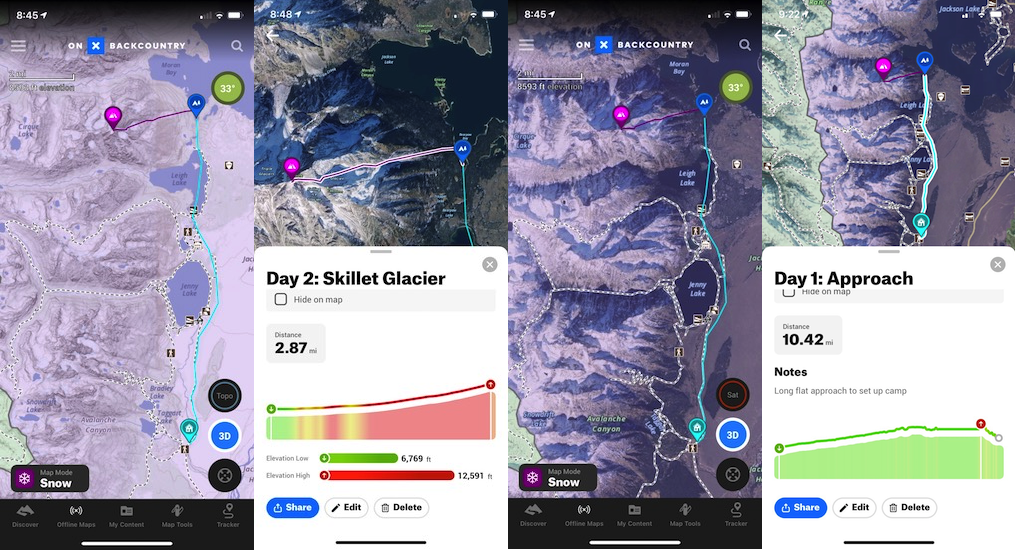
The OnX Backcountry 2D Topo map and our stats for Day 2 (left) and the 2D Satellite map with our stats for Day 1 (right).
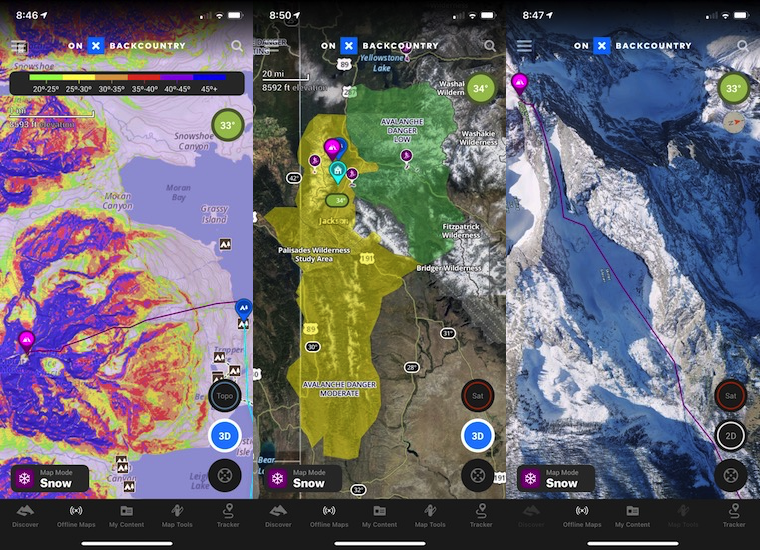
OnX has Snow Map Mode specific features: Slope Angle Shading (left), Avalanche Forecasts (center) and a 3D Satellite mode (right) with winter imagery. These all played helpful roles in planning out our ski on Mount Moran.
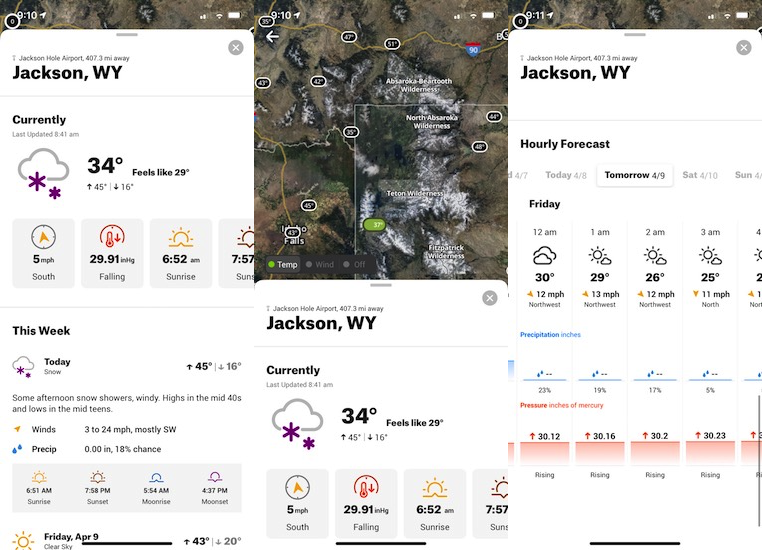
The OnX integrated weather conditions and forecast make point forecasting weather easy. There are current weather conditions for Jackson (left), weather overlays for temp and wind (center) and a detailed forecast (left).
Trip Report
To preface our trip report…things didn’t go as planned (do they ever?). Gavin and I had lofty plans to ski things that would push ourselves in the mountains. But then life outside of skiing got in the way and we stepped back our plans to match those life-circumstances. But then both Gavin and I got our first round of the COVID vaccine the day before our trip…and plans changed again!
Day One
Day 1 was intended to be an early start to approach camp, set up camp, and go for a small ski to assess conditions in the afternoon. What actually happened was I woke up in the morning feeling like I got hit by a small bus [in the form of a COVID-19 vaccine]. Considering I had limited time in the Tetons, I slogged my way through the morning in hopes of approaching camp to feel better the next day.
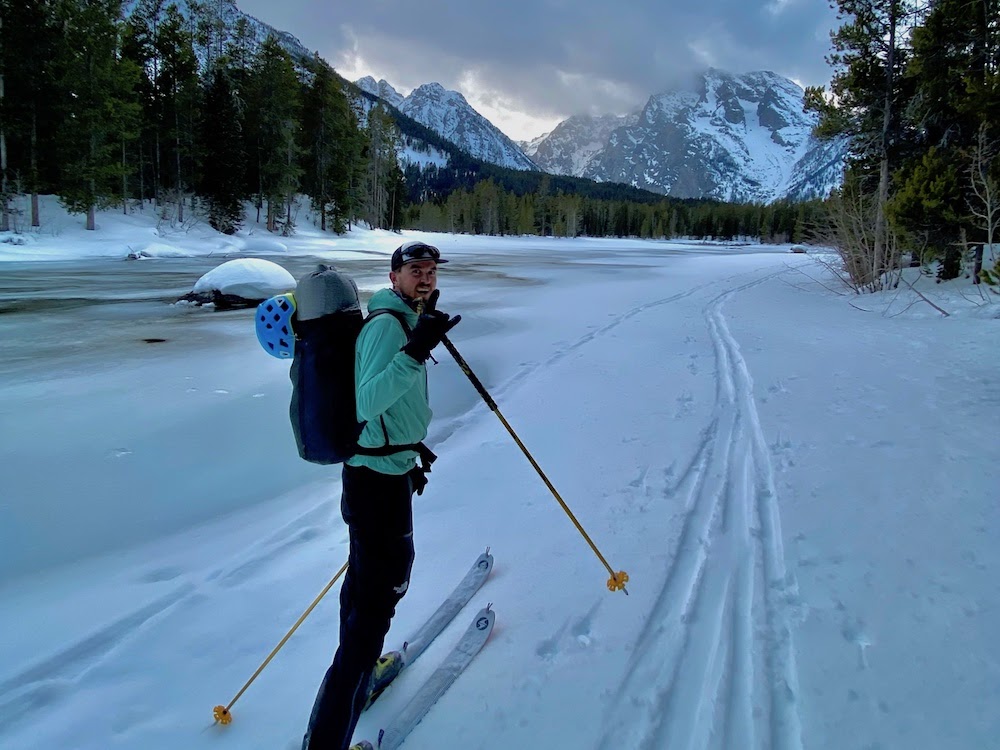
Gavin is approaching in high spirits. Good for him. The weather was more mixed than expected, but the flat tour to Leigh Lake was a nice way to be outside without too much exertion, considering my body felt like a pile of rubble.
We approached on the pleasant and flat Teton Park Road with a grand view of the Tetons to keep us company. We made it to Leigh Lake (just south of our intended destination of Jackson Lake) before deciding to set up camp and call it a night. My condition hadn’t improved through the approach, so we decided to cancel our plans of attempting a ski on Mount Moran the next day. Instead, we opted for a more mellow tour to assess general conditions, enjoy being in the company of big mountains, and scope potential lines for later down the line!
Day Two
We woke up on day 2 with a plan to ascend a southern apron near Mount Moran. This was a new area for both Gavin and I, so we entered this terrain cautiously. We hoped for the southern apron to heat up throughout the day and make for a delightful, low-stress corn ski back down to the tent. The day was as forecasted: clear and cool. We ascended the apron, scoped A LOT of fun looking skiing for next time when I feel better, and shared plenty of quality conversation along the way. I really appreciate Gavin as a ski partner and friend for his patience with our change of plans. It’s tough to cancel lofty missions, but it just wasn’t in the cards!
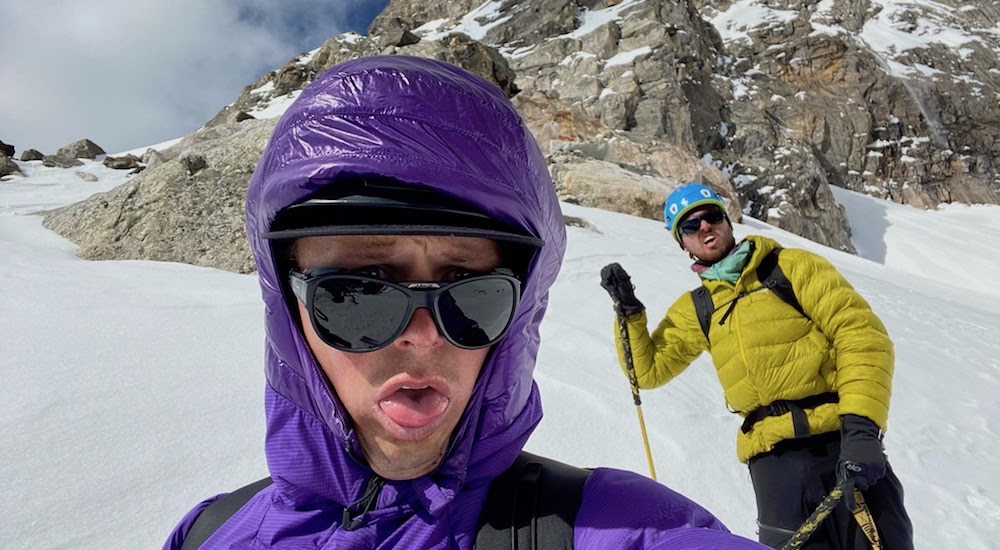
This was the general mood for the day. Beautiful weather, but gross face for the gross feeling inside my body.
After our corn harvest of a ski down the apron, we packed up camp and made the long egress out on Teton Park Road. Gavin is an exceptional nordic skier, so he was sharing pointers for how to skate back to the car. Even with Gavin’s great advice, I was fully redlining for almost the entirety of our skate. Guess that’s something I need to work on for next time! I feel grateful for our time spent in the mountains, even if they didn’t go according to plan.
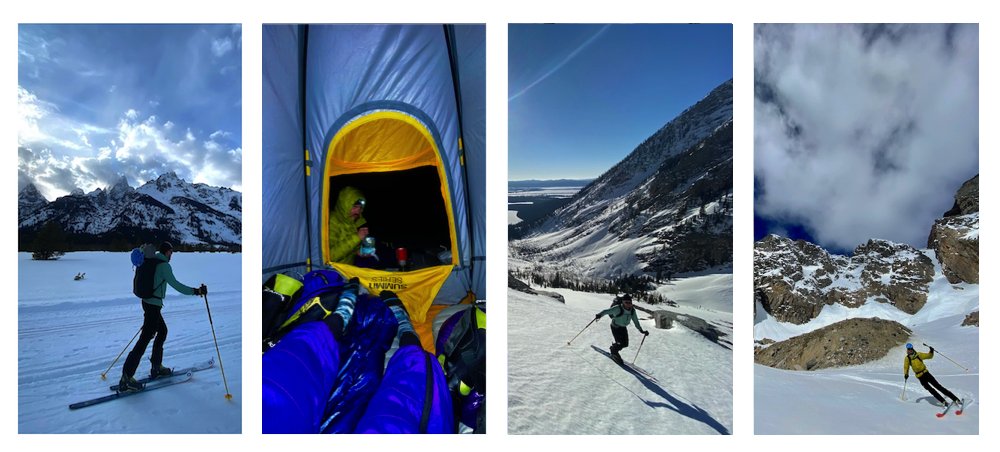
Here are some extra shots from our trip (from left to right): Gavin approaching camp with divine lighting and cloud cover in the Tetons; Gavin eating a dehydrated dinner while I’m getting set for bed and drying gear in the tent; Gavin touring up an apron on Mount Moran in hopes to get some views of nearby ski lines; alas, we did indeed harvest incredible corn on Day 2.
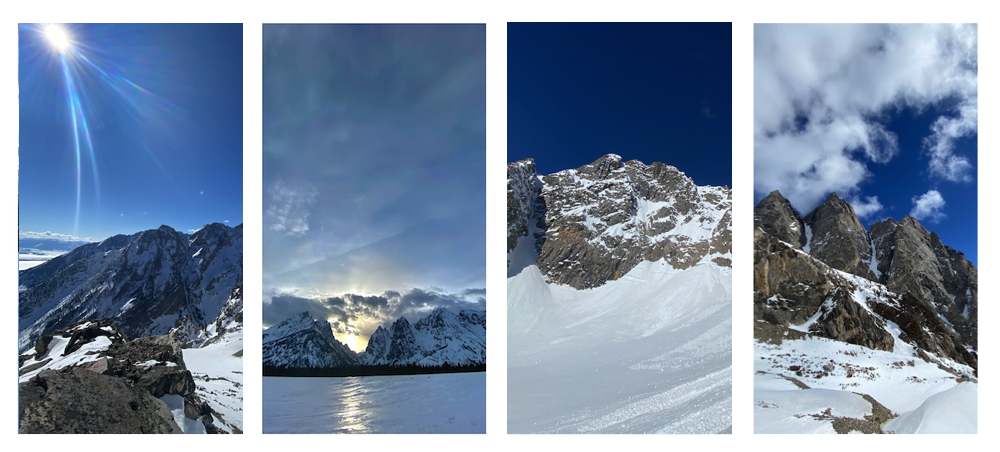
Here are some beautiful views of beautiful mountain landscapes during our time in the backcountry. Sometimes it’s not about how much vert you logged or how many double-pole-plant hop-turns you scored. Sometimes it’s about time spent and awe inspired in these stunning landscapes.
Debrief
So our preliminary plans for a lofty ski mountaineering objective didn’t come together. Nor did our plan B. But Plan C still involved quality time in a stunning location with my best friend AND some good ol’ corn skiing. That is success in my books, even if it wasn’t the original goal.
Did conditions match the forecast?
We had sunny and calm weather with a transitional spring time snowpack, just as forecasted. We didn’t quite make it to our camp on Jackson Lake because my body felt like a trash can and our plans to ski the Skillet Glacier didn’t feel reasonable given my condition.
Where were we most at risk?
Skiing too fast through the trees when returning to camp led me to digging a tip into firm snow and crashing. I wasn’t hurt, but the crash was a testimate to me feeling quite poor that day. No harm, no foul right? (below tree line, non avalanche hazard is something to not take for granted!).
What would we do differently next time?
I would try to be more careful with my body beforehand and prioritize feeling 100% before a big planned trip. Is getting the COVID-19 vaccine more important than a ski trip…yes? So it was hard to account for how I would feel post-vaccine.
The last point that I would like to include in my debrief process is to submit a field report to the local avalanche forecast center (Submit a BTAC field observation here or BTAC avalanche event here). Forecasts centers like BTAC rely on crowd-sourced knowledge, and any information that you can share from your tour helps forecasts centers forecast, and thus helps us stay safe in the backcountry.
Thanks for tuning in and keep your eye out for the next chapter: The Elks!
Slator Aplin lives in the San Juans. He enjoys time spent in the mountains, pastries paired with coffee, and adventures-gone-wrong. You can often find him outside Telluride’s local bakery — Baked in Telluride.
